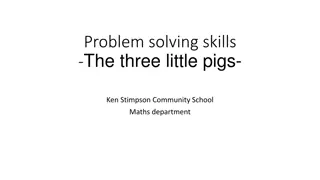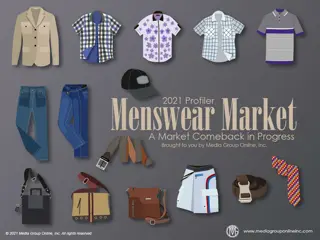Challenges and Opportunities in Shopping Center Industry
The International Council of Shopping Centers (ICSC) reports an improvement in tenant occupancy rates for shopping centers in Q1 2022, with challenges such as the reduction of gross leasable area persisting. Inflation has affected foot traffic, particularly in outlet malls. Major developers are focusing on outlet mall projects, recognizing consumer preferences. The impact of work-from-home trends has shifted shopping behaviors, affecting urban and suburban malls differently. E-commerce continues to grow, posing an opportunity amid changing retail landscapes.
Download Presentation

Please find below an Image/Link to download the presentation.
The content on the website is provided AS IS for your information and personal use only. It may not be sold, licensed, or shared on other websites without obtaining consent from the author.If you encounter any issues during the download, it is possible that the publisher has removed the file from their server.
You are allowed to download the files provided on this website for personal or commercial use, subject to the condition that they are used lawfully. All files are the property of their respective owners.
The content on the website is provided AS IS for your information and personal use only. It may not be sold, licensed, or shared on other websites without obtaining consent from the author.
E N D
Presentation Transcript
Back on Track, But Challenges Persist According to the International Council of Shopping Centers (ICSC), the Q1 2022 tenant occupancy rate for all shopping centers was 90.5%, the most since 2020. The open-air mall rate was 91.9%, but the 84.5% rate for malls was only 0.01% more than Q1 2021. The continued reduction of gross leasable area (GLA) for retail space is a persistent challenge. The ICSC reports that GLA was 64.9% during Q1 2022, compared to 65.8% during 2020 and 70.6% during 2016. The rapid decline in retail store closures is good news for malls. Following the 4,974 store closures during 2020, just 589 closed during 2021 and none closed during Q1 and Q2 2022.
Inflation Stymies Foot Traffic Placer.ai s June 2022 report of shopping mall visits shows a decrease from January through June in parallel with the increase in inflation. During January, indoor mall visits increased 26.7%, open-air lifestyle centers increased 28.3% and outlet malls increased 5.2% YOY. During May, indoor mall visits increased 6.3%, open-air lifestyle centers increased 4.0% and outlet malls decreased 6.6% YOY, respectively. June visits decreased further: indoor malls at +1.5%, open-air lifestyle centers at +0.5% and outlet malls at -6.7%. A month-to-month comparison reveals a different pattern. After visits to all three mall types increased from April to May, visits to indoor malls decreased 3.7% and open-air lifestyle centers decreased 2.4%, but outlet malls increased 0.6%, from May to June.
The Outlet Mall Outlook Many major outlet mall owners, such as Tanger and Simon Property Group, have returned to the active development of planned, new properties, which have been delayed for several years. Many shoppers are more comfortable shopping at outlet malls than indoor malls. Just these two developers outlet mall projects will total 1.8 million square feet, a substantial increase when compared to the 1.2 million square feet of all outlet mall space that opened from 2019 to 2021. Approximately 65% of outlet mall tenants are apparel and apparel-related retailers. Although consumers must purchase clothing, inflationary pressures could negatively affect outlet mall sales. Many in the sector are calling for a more diverse tenant mix.
The Impact of Work- from-Home Shoppers Although many companies have asked/required employees to return to the workplace at least a few days per week, there is stiff resistance from many workers who find working from home more productive. This trend has affected shopping malls. The combination of more workers at home during the day and many urban households moving to the suburbs during 2020 to escape the pandemic moved daytime shopping from urban to suburban shopping centers and areas. This trend has resulted in vacancy rates at suburban malls being lower than those at urban malls for the first time during the past 15 years, but rental rates have increased faster at suburban malls than urban malls.
Targeting the E-Commerce Opportunity During Q1 2022, e-commerce sales accounted for 14.3% of all retail sales, according to the US Census Bureau, and are forecasted to reach 21.9% by 2025, according to Statista; however, shopping malls generate almost no e-commerce revenues, only their tenants. As those tenants offer an omnichannel shopping experience to their customers and have digitized customer information, more shopping malls are realizing they must do the same. Some mall owners are starting robust communication programs with visitors via social media, digital readerboards, Websites and email campaigns. They are using this information to understand visitor habits and shopping trends at malls and to target future tenants.
Proactive Trends Simon Property Group is addressing the declining foot traffic at its malls with Simon Search, an app that mall visitors can use to search for the items they want and to determine if they re available at mall stores. Simon s goal is to attract more visitors. More empty malls are being converted to last-mile distribution centers for major retailers, both chains and online. Although there are various challenges to these conversions, empty malls are typically near transportation networks and residential communities. Macerich, which owns and operates 33 indoor malls and open-air centers, is welcoming more entertainment-based tenants to its properties, such as bowling and amusement centers and a greater diversity of dining options at various price points.
Advertising Strategies Because shoppers feel safer at open-air malls, these property owners and management can cite this advantage in their advertising messages, especially to attract older adults. Outlet malls are known for their bargains, which are top of mind for consumers to combat the high costs of goods, caused by inflation. Aggressive advertising with a mix of a reach medium and direct mail, for example, is a good strategy to increase foot traffic. Many malls have been hosting various types of events, but unusual events and exhibitions are more likely to attract an audience that is not typical mall visitors and create more opportunities for tenants to create new customer relationships.
New Media Strategies As many people continue to work from home, suburban mall locations can use social media combined with radio to offer midday specials, such as digital coupons, to mall dining establishments to generate more lunch traffic. Malls that expect to remain competitive require multi- dimensional communication programs with visitors. They can use social media and email campaigns to ask visitors what types of communication channels they prefer and the content that will enhance their lives. Malls can use their visitor communication programs to post the status of tenants inventory, delivery and other supply- chain challenges in a database, so customers are less concerned or upset with delayed merchandise and slow fulfillment of their orders.























